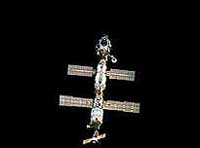 ISS December 2000 |
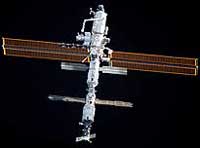 ISS July 2001 |
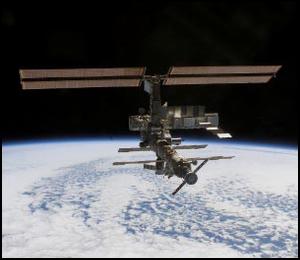 ISS October 2002 |
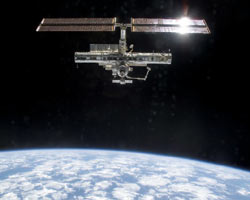 ISS December 2002 |
During its third year of continuous international human presence in orbit, the orbiting outpost continued to grow as the largest, most sophisticated and most powerful spacecraft ever built.
Because of the the tragic space shuttle Columbia accident, the third year of humans living aboard the station will be remembered for the endurance of the orbiting laboratory and the perseverance of the international partnership.
Partners. The International Space Station partnership includes the U.S. space agency NASA, the Russian Space Agency Rosaviakosmos, the European Space Agency, the Japanese Aerospace Exploration Agency, and the Canadian Space Agency.
Until shuttles return to flight, supplies and crews are ferried to the ISS by Russian Soyuz and Progress spacecraft.
Growth. Known as International Space Station Alpha, the ISS has grown from a 70-ton foothold the size of an efficiency apartment in orbit to a space laboratory of unprecedented capability. During the three years, repeated visits by U.S. space shuttles and Russian cargo rockets – crammed with equipment and segments – have increased the volume of the station to a three-bedroom house. Today the station is a 200-ton orbiting complex.
During its third year of occupancy, the nature of the station's occupancy changed. The loss by the United States of shuttle Columbia on February 1, 2003, stopped for a time the ability of the station's partners to send large modules to the ISS.
At the Kennedy Space Center (KSC) in Florida, 168,000 lbs. of additional components are standing by for launch when U.S. shuttles resume flights – probably sometime around the end of the fourth year of ISS occupancy.
When they arrive at the station, those components will triple the number of science facilities aboard the orbiting laboratory, increase the total power available for research by over 80 percent and tripling the surface area of the space station's solar arrays.
Among the large modules awaiting launch on the ground at KSC are America's Italian-built Node 2 and a second laboratory for the station, the Japanese Experiment Module (JEM) named Kibo (Hope). When Node 2 is flown in a shuttle to space and attached to the Destiny laboratory, it will increase the living and working space inside the Space Station to approximately 18,000 cubic feet. It also will allow the attachment of JEM as well as Europe's future Columbus general-science laboratory and America's future Centrifuge Accommodation Module for gravitational biology research.
Node 2 will distribute electrical power, heating and cooling to the labs and to the docks for the moving-van Multipurpose Logistics Modules that will carry cargo and experiment racks to and from the ISS. more about node 2
When the shuttle fleet resumes travel to space, assembly missions could be flown almost every month to the station.
Size. During its third year of human residency, the habitable pressurized volume of the station was equal to the habitable space in an 1,800-square-ft. three-bedroom house with 8-ft. ceilings.
The habitable pressurized volume on the completed station is expected to be 43,000 cubic feet. That would be about the volume of three average American houses, each one containing about 2,000 square ft. with 7-ft. ceilings for a total of around 14,000 cubic ft. each. That pressurized volume also would be roughly equivalent to the interior of a 747 jumbo jet.
The station remains the largest, most sophisticated. most powerful spacecraft ever built. It has a mass of almost 400,000 lbs.
The majority of the power, cooling, volume and research capacity on the station have been supplied by the United States.
Research. The space station's research capability also has grown during the two years it has been occupied. The U.S. Destiny Laboratory now houses seven different research facilities.
More than 90,000 hours of experiments have been conducted. The U.S. has launched 65 science projects and numerous studies have been initiated by other nations.
One example of research aboard the station saw the first-ever crop of soybeans grown in space. After 100 days aboard the station, the seeds were returned to Earth where they were tested for months to reveal whether their growth in a low-gravity environment changed their chemical composition. Soybeans are a leading source of protein in the human diet and are used in many products, from oil to crayons.
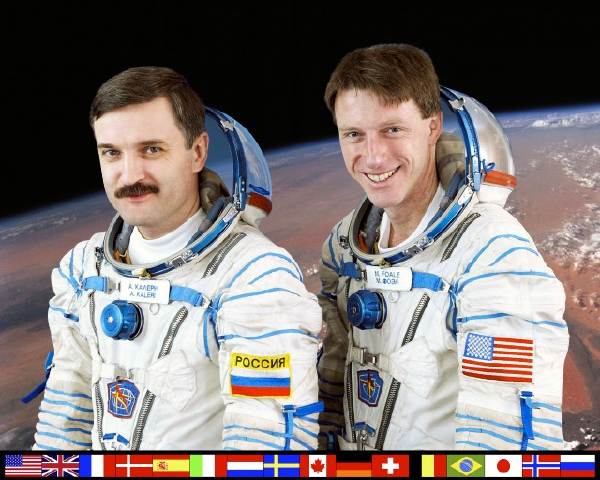 ISS expedition Eight crew members Alexander Kaleri and Michael Foale [NASA] |
The eighth resident crew – Commander and NASA ISS Science Officer Mike Foale and Flight Engineer Alexander Kaleri – began a six-month stay aboard the complex October 20, 2003.
During its first two years, a total of 112 visitors went to the station, including men and women from six nations. During the second year, 33 people visited or lived aboard the orbiting complex.
Eight three-person and two-person crews have lived aboard the station for durations ranging from four to more than six months.
Previous years. During its first year of permanent occupation, the International Space Station had been home to three crews totaling nine long-term residents, including five Russian cosmonauts and four NASA astronauts.
In its second year of occupancy, astronauts and cosmonauts conducted 16 spacewalks for maintenance and assembly of the station. During the first year of human occupancy of ISS, a total of 18 spacewalks were completed. That was more spacewalks than in any previous 12-month period in the history of human space flight.
During each crew's watch, one of Russia's Soyuz capsules is on hand for use as an emergency lifeboat. Every six months, Russia sends a fresh Soyuz to replace the one docked at the station. Russia also has sold station trips to wealthy tourists.
Crew Changes. ISS crews rotate during crew exchange flights. There is a handover when an incoming crew replaces the outgoing crew. A current space station crew communicates by radio to the future crew on Earth information about special situations they have encountered as well as new techniques learned and other topics necessary for life aboard the space station. Once the new crewmembers arrive at the station, the outgoing crew briefs them on safety issues, vehicle changes and payload operations.
The ISS continues the era of sustained human exploration, following on the fifteen years of exploration by Russia's Mir space station. Astronauts and cosmonauts who serve aboard the orbiting outpost will increase our knowledge of what it's like to live in space and how to sustain long-term operations in space.
As the largest international engineering project ever undertaken in space, ISS is the first truly global space exploration effort. NASA hopes its unprecedented scale in orbital size and capability will be matched in the future by the scale of the benefits its research will bring to lives on Earth. The International Space Station exemplifies the benefits of international cooperation in space.
Learn more:
- NASA information and images
- New crew arrives with STS-113 November 25, 2002
- P1 Truss attached November 26, 2002
- First two-member crew arrives April 28, 2003
- First ISS crew landing in Soyuz May 3, 2003
- Three Russian vehicles docked to ISS June 11, 2003
- 1,000th day of human presence on ISS July 29, 2003
- Crew rotation October 20, 2003
- Space Today Online space station stories STO